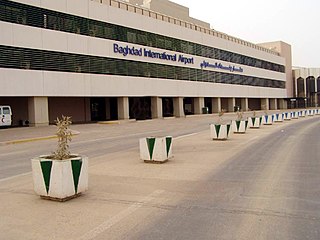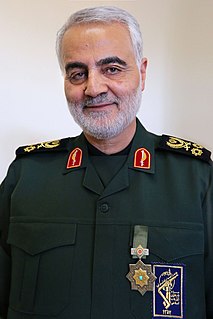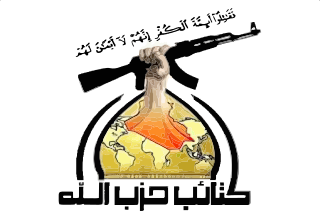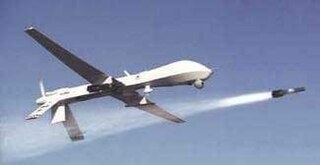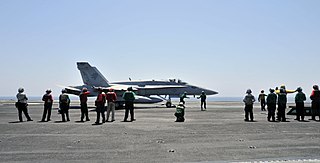A request that this article title be changed to Assassination of Qasem Soleimani is under discussion. Please do not move this article until the discussion is closed. |
| 2020 Baghdad International Airport airstrike | |
|---|---|
| Part of the American-led intervention in Iraq and the Persian Gulf crisis | |
 The explosion from the airstrike, as seen from a nearby suburb | |
| Type | Drone strike [1] |
| Location | 33°15′29″N44°15′22″E / 33.25806°N 44.25611°E Coordinates: 33°15′29″N44°15′22″E / 33.25806°N 44.25611°E |
| Target | Qasem Soleimani [2] |
| Date | 3 January 2020 About 1:00 a.m. [3] (local time, UTC+3) |
| Outcome | See Aftermath |
| Casualties | 10 killed, including Qasem Soleimani and Abu Mahdi al-Muhandis |
| ||
|---|---|---|
Incumbent
Presidential campaigns Controversies involving Russia Business and personal  | ||
On 3 January 2020, a United States drone strike near Baghdad International Airport targeted and killed Iranian major general Qasem Soleimani of Iran's Islamic Revolutionary Guard Corps (IRGC) while he was planned to meet Iraqi PM Adil Abdul-Mahdi in Baghdad. Soleimani was commander of the Quds Force—which has been designated a terrorist organization by the U.S., Canada, Saudi Arabia and Bahrain—and was considered the second most powerful person of Iran, subordinate to Supreme Leader Ali Khamenei. Nine others were killed alongside Soleimani, including four Iranian and five Iraqi nationals such as deputy chairman of Iraq's Popular Mobilization Forces (PMF) and commander of the Iran-backed Kata'ib Hezbollah militia, Abu Mahdi al-Muhandis—a designated terrorist in the U.S. and in the United Arab Emirates (UAE).
Contents
- Background
- Assassination as a policy consideration
- U.S. and Iranian activities in Iraq since 2014
- Political considerations
- Importance of the assassination of Qasem Soleimani
- Prior threats against Soleimani
- Prelude
- Pentagon evaluation
- Trump briefing
- Soleimani's trip to Iraq
- Attack
- Casualties
- Contemporaneous assassination attempt
- Aftermath
- Alleged Taji road airstrike
- Iranian response
- Iraqi response
- Legality
- Alleged violation of international law
- In terms of agreement with Iraq
- Domestic laws of the United States
- Reactions
- See also
- Notes
- References
- External links
The strike occurred during the 2019–20 Persian Gulf crisis, which began after the U.S. withdrew from the 2015 nuclear deal with Iran in 2018, reimposed sanctions, and accused Iranian elements of fomenting a campaign to harass U.S. forces in the region. On 27 December 2019, the K-1 Air Base in Iraq, which hosts Iraqi and U.S. personnel, was attacked, killing an American contractor. The U.S. responded by launching airstrikes across Iraq and Syria, killing 25 Kata'ib Hezbollah militiamen. Days later, Shia militiamen and their supporters retaliated by attacking the U.S. embassy in the Green Zone.
U.S. officials justified the strike claiming it was necessary to stop an "imminent attack", though later clarifying the legal justification of the action as being taken "in response to an escalating series of attacks...to protect United States personnel, to deter Iran from conducting or supporting further attacks...and to end Iran's strategic escalation of attacks..." [4] Some critics of the strike questioned the legality of the attack with respect to international law, as well as the domestic laws of the U.S. Iran called the strike an act of "state terrorism". The Iraqi government said the attack undermined its national sovereignty and considered it a breach of its bilateral security agreements with the U.S. and an act of aggression against its officials. On 5 January 2020, the Iraqi parliament passed a non-binding resolution to expel all foreign troops from its territory while, on the same day, Iran took the fifth and last step of reducing commitments to the 2015 international nuclear deal.
Soleimani's killing sharply escalated tensions between the U.S. and Iran and stoked fears of a military conflict. Iranian leaders vowed revenge, while U.S. officials said they would preemptively attack any Iran-backed paramilitary groups in Iraq that they perceived as a threat. Many in the international community reacted with concern and issued statements or declarations urging restraint and diplomacy. Five days after the airstrike, Iran launched a series of missile attacks on U.S. forces based in Iraq, the first direct engagement between Iran and the U.S. since Operation Praying Mantis in 1988. Following the shootdown of Ukraine International Airlines Flight 752 amidst the escalation, leaders from both countries seemed reluctant to further escalate the crisis.






